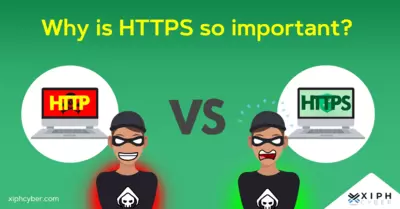Published Jun 10, 2022 by Xiph
The world of website security abounds with obscure acronyms, and none are more misunderstood than internet protocols like HTTP and HTTPS. While both allow communications between web browsers and web servers, it’s important to understand the basics of how they work and what their differences are.

HTTP vs HTTPS: What are the differences?
HTTPS is HTTP with encryption. The ‘S’ stands for ‘secure’ at the end of the protocol − Hypertext Transfer Protocol Secure (HTTPS). The only difference between the two protocols (both help web users transfer and receive information over the internet) is that HTTPS encrypts normal HTTP requests and responses, thus making HTTPS far more secure than HTTP. A website that uses HTTP has http:// in its URL, while a website that uses HTTPS has https://.
| HTTP | HTTPS |
| No encryption, so data can be intercepted and read by third parties | Encrypts all communications between web browsers and servers |
| Initial client-server network protocol, introduced in the 1990s, but now obsolete | Used to protect sensitive data including online transactions, passwords, private information |
| HTTP connections marked as ‘not secure’ by most web browsers | Helps with search engine rankings and can boost SEO efforts |
What is HTTP?
Hypertext Transfer Protocol (HTTP) was the protocol used by most early websites. At its most basic, it’s an internet communication protocol used to transfer data (website content, HTML files, images, API calls, query results, etc.) from a web server to a browser in order to allow users to view web pages. A protocol is a set of rules governing the format of data sent over the internet or other networks. There are two main kinds of HTTP messages: requests and responses.
HTTP requests are generated by a user's browser in the form of a request message to a named host located on a server. For example, if a user clicks on a hyperlink, the browser will send a series of ‘HTTP GET’ requests for the content to appear on the page.
An everyday example would be typing a query into Google like “best cyber security solutions Australia” and a series of articles would populate the search results for your consideration. Any links clicked on would generate/send a series of HTTP requests in order to get the information necessary to render the page. These HTTP requests go to either an origin server or a proxy caching server, and that server will generate an HTTP response.
Plain old HTTP transports information across the internet in plaintext. The problem is that anyone intercepting that traffic can read it, and this is especially an issue when users submit sensitive data (i.e. passwords, financial information, commercially sensitive data, etc.). HTTP leaves users vulnerable to middleman attacks, hackers, and online snoops.
What is HTTPS?
HTTPS is basically an HTTP protocol with additional security. The ‘S’ in HTTPS stands for ‘secure.’ HTTPS was originally used to protect the integrity of e-commerce transactions, emails, and other sensitive data transfers. Today, it’s the standard protocol used by all websites and web applications. HTTPS uses Transport Layer Security (TLS) or Secure Sockets Layer (SSL) to encrypt HTTP requests and responses, which will scramble plaintext into ciphertext to appear as a random sequence of characters to protect the data sent between two systems, and prevent online snoops and hackers reading or tampering with any information transferred, including potential personal details.
HTTPS secures communications by using public key encryption which uses two keys − a public key and a private key. The public key is shared with client devices via the server's SSL certificate. When a client opens a connection with a server, the two devices use the public and the private key to agree on new keys, called session keys, to encrypt further communications between them. All HTTP requests and responses are then encrypted with these session keys so that anyone who intercepts communications can only see a random string of characters, never the plaintext.

TLS vs SSL vs HTTPS: What's the difference?
HTTPS uses SSL/TLS as a sublayer to prevent unauthorised users from intercepting and tampering with sensitive data while it’s in transit between your web browser and internet servers. When a website uses HTTPS in its web address, it indicates that any communication taking place between a browser and server is secure. In other words, if your website is using HTTPS, all the information will be encrypted by SSL/TLS certificates. SSL was developed as one of the first encryption methods, and TLS is the successor protocol to SSL.
HTTP vs HTTPS: Which is better?
HTTPS is now the standard protocol for all websites and web applications. Encryption of internet connections is the norm, meaning all HTTP and unencrypted connections will be phased out in the next few years. Web browsers, tech companies, and the internet community as a whole have endorsed the use of HTTPS as the baseline for all web traffic. That’s in part because HTTPS is now a ranking factor in most search engines, including Google and Yahoo.
On the performance front, HTTPS is now also just as fast as HTTP, even with the added overhead of SSL. Most institutions and technology companies have committed to migrating older websites and services to HTTPS to keep business and customer information safe from intrusion.
Final word
HTTPS is the most basic security measure designed to protect online communications against cyber threats and attacks. It also helps with both performance and to boost the integrity of online businesses and websites. For tips on using HTTPS pages on your site, or fully migrating your website from HTTP to HTTPS, contact us via email: enquiries@xiphcyber.com.
Posted in: Security


